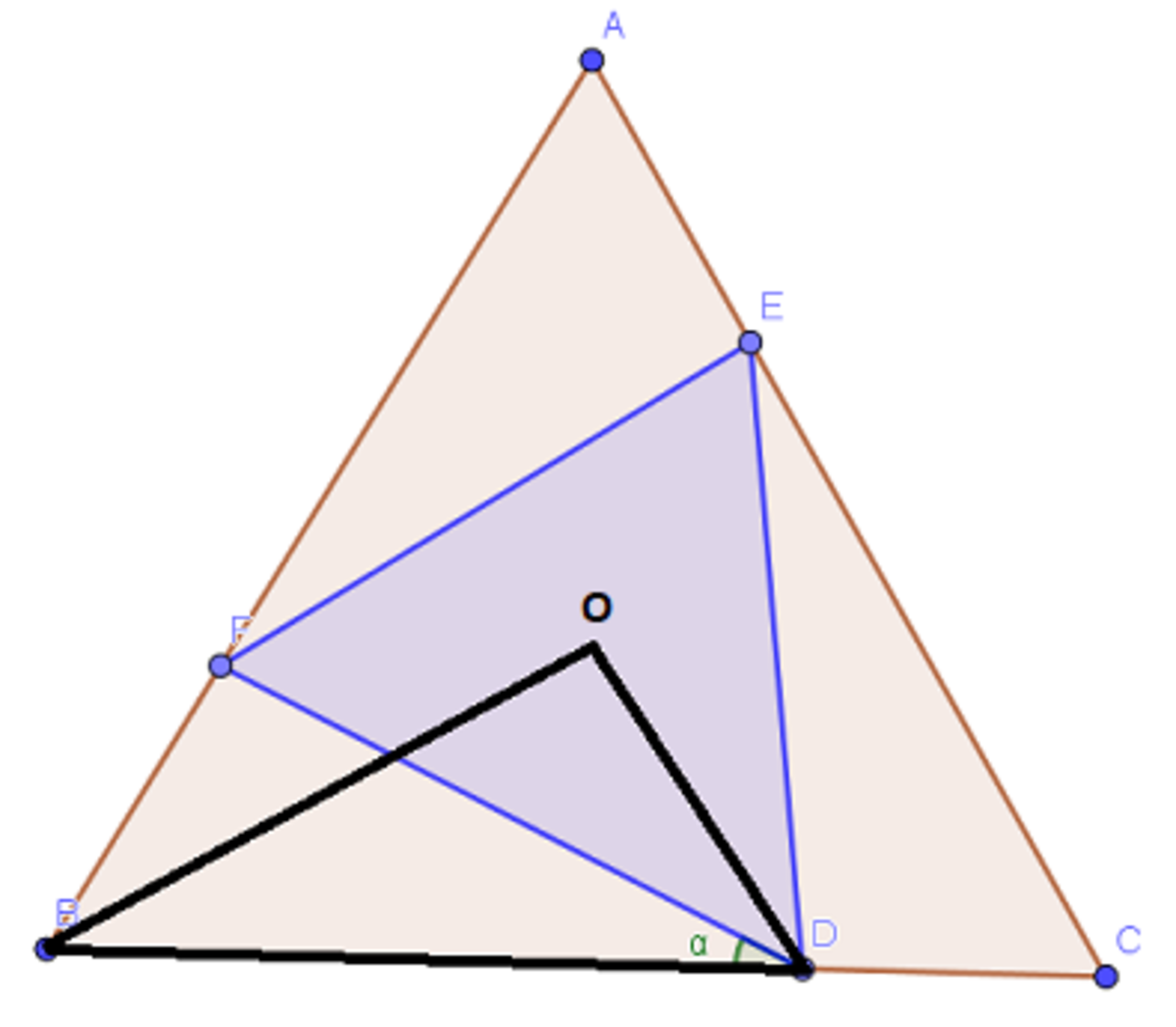Tilted and shrunk
△ A B C is an equilateral trianlge and D , E , F are three points on △ A B C such that △ D E F is also equilateral with an area half as big as that of △ D E F .
What is the measure of α = ∠ F D B ?
This section requires Javascript.
You are seeing this because something didn't load right. We suggest you, (a) try
refreshing the page, (b) enabling javascript if it is disabled on your browser and,
finally, (c)
loading the
non-javascript version of this page
. We're sorry about the hassle.
4 solutions
Let s be one of the sides of △ A B C . Since the ratio of the areas of △ A B C and △ D E F is 1 2 , the ratio of the sides is 1 2 , which means one of the sides of △ D E F is 2 2 s .
Let O be the center of both equilateral triangles. Then draw △ B D O .

Since B O is the length between the center and vertex of an equilateral triangle of side s , B O = 3 3 s , and ∠ C B O = 6 π . Since D O is the length between the center and vertex of an equilateral triangle of side 2 2 s , D O = 6 6 s , and ∠ F D O = 6 π . Then by law of sines, D O sin ∠ D B O = B O sin ∠ B D O , or 6 6 s sin 6 π = 3 3 s sin ∠ B D O , which solves to sin ∠ B D O = 2 2 .
Assuming ∠ B D O is an acute angle, ∠ B D O = 4 π , and ∠ F D B = ∠ B D O − ∠ F D O = 4 π − 6 π = 1 2 π .
Using Law of Sines, we have 2 equations to solve for 2 unknowns
S
i
n
(
y
)
x
=
S
i
n
(
6
0
)
2
1
S
i
n
(
1
2
0
−
y
)
1
−
x
=
S
i
n
(
6
0
)
2
1
which gets us y = 1 5 degrees
Since we are finding the measure of an angle, we may assume A B = B C = A C = 1 and we also get that E F = F D = D E = 2 2 .
Notice that Δ E A F ≅ Δ F B D ≅ D C E because of the ASA Postulate. So let B D = 1 − F B = x .
Applying Law of Cosines on Δ F B D
( 2 2 ) 2 = x 2 + ( 1 − x ) 2 − 2 x ( 1 − x ) cos 6 0
⟹ x = B D = 6 3 + 3
⟹ 1 − x = B F = 6 3 − 3
Now applying Law of Cosines again on Δ F B D but with ∠ F B D = α
( 6 3 − 3 ) 2 = ( 2 2 ) 2 + ( 6 3 + 3 ) 3 − 2 ( 2 2 ) ( 6 3 + 3 ) cos α
⟹ cos α = 4 6 + 2
⟹ α = 1 2 π .
The only question I have in mind in this problem is that if it is actually possible to have 2 cases of inscribing Δ F D B . 1.) BD > BF ; BD < BF. In the later case, we get α = 1 2 7 π .
Log in to reply
You're right. I assumed that with the drawing and the fact that all the answers are lower than pi/6, it would not pose a problem.
WLOG, let the side length of △ A B C be 1 . If B F = x , then B D = 1 − x .
By symmetry (or a simple congruency proof) the areas of △ B F D , △ C D E and △ A E F are equal, so the area of △ B F D is one-sixth of the area of △ A B C . Then
2 1 ( B F ) ( B D ) sin ∠ F B D ( B F ) ( B D ) x ( 1 − x ) 6 x 2 − 6 x + 1 x = 6 1 ⋅ 2 1 ( A B ) ( B C ) sin ∠ F B D = 6 1 ( A B ) ( B C ) = 6 1 ( 1 ) ( 1 ) = 0 = 6 3 ± 3
Since the area of △ D E F is half the area of △ A B C , the ratio of the side lengths will be 2 1 , so D F = 2 1 . Then applying Sine Law to △ B D F ,
B F sin ∠ B D F ( 6 3 ± 3 ) sin α sin α α = 1 2 π = D F sin ∠ F B D = ( 2 1 ) ( 2 3 ) = 4 6 ± 2 OR α = 1 2 5 π
But we know α < 3 π because when α = 3 π , the area of △ D E F is clearly one-fourth of the area of △ A B C . So our answer is α = 1 2 π